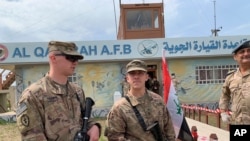Improved performance by Iraqi military forces is allowing the United States and Iraq to look ahead to the day when U.S. forces will no longer be needed to help Baghdad stave off the threat from the Islamic State terror group and its remnants.
In a communique issued Wednesday following virtual talks between U.S. Secretary of State Antony Blinken and Iraqi Foreign Minister Fuad Hussein, the two countries agreed to embark on technical talks aimed at establishing a timeline for U.S. combat troops to leave.
“The mission of U.S. and Coalition forces has now transitioned to one focused on training and advisory tasks, thereby allowing for the redeployment of any remaining combat forces from Iraq,” the communique stated, pointing to the “increasing capacity” of the Iraqi security forces.
In a tweet late Tuesday, Iraqi Prime Minister Mustafa al-Kadhimi described the talks with Washington as a “gateway to restore the normal situation in Iraq” and said the Iraqi people deserve to live without fear of conflict.
The U.S. currently has about 2,500 troops in Iraq and just under another 1,000 troops in neighboring Syria. They have been tasked with supporting Iraqi forces and the coalition-backed Syrian Democratic Forces (SDF) to keep pressure on Islamic State, as it has sought to resurrect its fortunes just over two years after the last remnant of its self-declared caliphate fell to U.S.-backed forces in Syria.
U.S. forces also conduct aerial surveillance missions and airstrikes in support of the Iraqi forces and the SDF, though Iraq’s military has carried out a growing number of airstrikes itself in recent months.
U.S. officials, speaking after the virtual talks, emphasized that for now, Islamic State, also known as IS, ISIS or by its Arabic acronym, Daesh, remains a threat and that there is no plan to begin pulling U.S. troops from Iraq in the near term.
"We've all been working towards the eventual redeployment when we both agree, and the Iraqis believe that there's a need for that mission to end, and there's no need for American support on the ground,” Pentagon press secretary John Kirby told reporters during a briefing Wednesday.
“We didn't go in there with the idea of being a permanent presence,” he said. “The idea was to defeat ISIS. And that's still the goal.”
U.S. officials, of late, have described the threat from IS as “diminished,” and intelligence estimates indicate the terror group’s ranks have thinned to perhaps as few as 8,000 fighters across Iraq and Syria, a fraction of the 34,000 to 100,000 fighters who roamed the region during the caliphate’s brief heyday.
U.S. military officials have also been quick to praise Iraqi forces, especially the elite Counterterrorism Service (CTS), for eroding the terror organization’s capabilities.
In the first three months of 2021, Iraq’s CTS carried out more than 100 operations against IS, killing 34 fighters and arresting another 99.
Iraqi forces, and the Iraqi air force, were also credited with playing a major role in a massive air campaign last month that destroyed 120 hideouts being used by IS in Iraq’s Makhmour Mountains.
“They are a much better force now than they were before,” the Pentagon’s Kirby said, assessing the progress Iraq’s military has made since U.S. and coalition forces were first sent to Iraq to push back IS.
“They have improved their capability and responded to the training and the assistance that they've been getting,” he added.
Despite that improvement, U.S. and coalition officials have been quick to argue that it would be dangerous to ease up on IS cells and remnants.
"The threat remains," foreign ministers with the Global Coalition to Defeat IS said in a statement following a virtual meeting last week.
Of particular concern has been the group’s ability to hide and gain strength in areas where Iraqi, SDF, and U.S. and coalition forces are unable to operate, including parts of Syria nominally under the control of the Syrian government or its Russian and Iranian allies.
There are also concerns that IS operatives, working with criminal networks, are still finding ways to flow to areas with the least security and counterterror pressure, often exploiting the porous border between Iraq and Syria to move people, cash and weapons.
Nike Ching contributed to this report.










